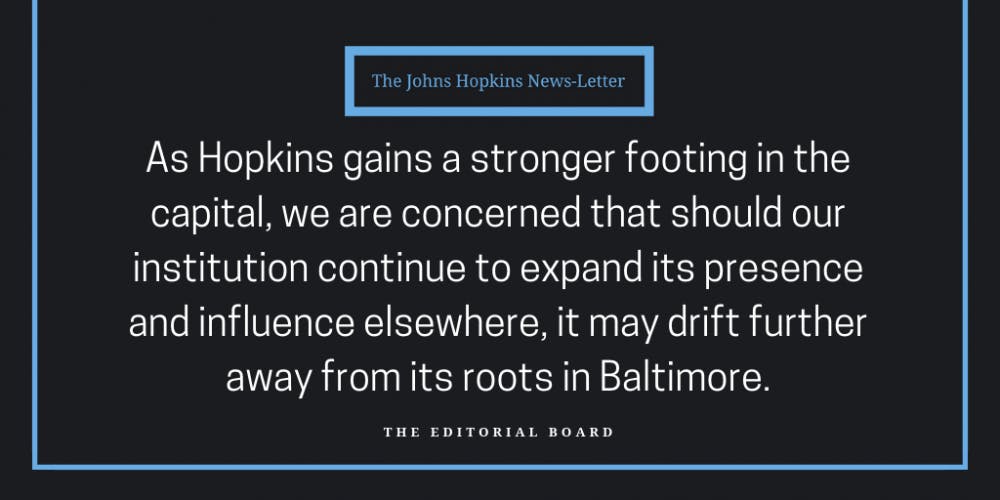Last Friday, many of us received an email that Hopkins had purchased the building that currently houses the Newseum, a museum in Washington, D.C. that is dedicated to promoting freedom of speech. Located on Pennsylvania Avenue, the building is positioned at the heart of the nation’s capital and will primarily be used to centralize the University’s graduate programs, including the Paul H. Nitze School of Advanced International Studies (SAIS).
In many ways, this purchase is great news. It introduces new opportunities for our affiliates, particularly those who commute to D.C. or are based there. It expands the University’s presence in the capital and gives us a greater role in debates over public policy. It provides a platform for networking and an exchange of valuable resources between Hopkins and the rest of D.C.
Yet as Hopkins gains stronger footing in the capital, we are also concerned that should our institution continue to expand its presence and influence elsewhere, it may drift further away from its roots in Baltimore.
Granted, buying the Newseum is hardly an indicator that Hopkins will move to D.C. But Hopkins could use the Newseum purchase and the threat of moving development to other cities as lobbying leverage in Baltimore. For example, just last year, Amazon warned that increased taxes at its Seattle headquarters would force the company to reconsider its future growth in the city. Hopkins needs Baltimore’s support on the creation of a private police force. With Hopkins turning its attention away from Baltimore at this crucial moment, it’s hard to know whether the city’s stance on the police force could become influenced by its interest in keeping Hopkins happy in its home city.
Drawing the comparison to Amazon also isn’t too far of a leap. Hopkins may be a home to many of us, but in Baltimore it’s also a business — and a big one, at that. The University is the largest private employer in Baltimore by far. As of 2010, Hopkins employed over 30,000 people in the city, about half of which were Baltimore City residents. Since 2010, Hopkins has paid approximately $10 million to the city in payments in lieu of taxes (PILOTs). Our institution’s economic power in the city is formidable to say the least, something that invariably underpins our relationship with the city.
To be sure, the University has made some substantial efforts to give back to Baltimore. In December 2012, Hopkins announced the Homewood Community Partners Initiative (HCPI) to stimulate community partnerships in ten neighborhoods near Homewood Campus. In 2015, Hopkins launched HopkinsLocal in an effort to increase the University’s investment in Baltimore-based small businesses. And in 2017, the University’s 21st Century Cities initiative funded five research projects addressing urban policy improvements in Baltimore. Through these endeavors, the University has shown a vested interest in helping Baltimore residents on both a financial level and policy level.
However, we should also keep in mind that in expanding its footprint in the city, Hopkins also risks harming Baltimore. It has been rigorously gentrifying parts of the city over the past few years, which President Daniels calls an “enlightened form of self-interest.” This gentrification forces vulnerable community members and minorities out of their homes as they struggle to meet ever-increasing living costs. It doesn’t help that many of us at Hopkins maintain a distance from the city, living comfortably in the “Hopkins bubble,” reluctant to explore beyond affluent neighborhoods.
Hopkins is a great hub of young talent, but too many of us leave the city upon graduating. The University can do more to prevent ‘brain drain’ — the phenomenon where smart students flock to elite, urban universities and then leave upon graduation. It should work harder to keep young talent here. A good initiative already in place, for example, is the School of Education’s Baltimore Education Fellows Scholarship. Through the fellowship, Hopkins graduates who are interested in urban education are put in an accelerated masters program where they complete internships in Baltimore City schools.
More importantly, we should not forget that as long as we are here, Baltimore is our home, and there is so much in our city to love and be thankful for. Granted, it’s not realistic or fair to expect everyone to stay, but while we look to opportunities in other cities, we should appreciate all that Baltimore already has to offer. And brain drain may be a trend that’s slowly changing: in a 2017 interview with The News-Letter, Daniels said that more students are staying in Baltimore. The University can and should continue to guide students on this path.
As our president likes to say, “as goes Baltimore, so goes Hopkins.” But in light of our institution’s relationship with the city, it’s easy to see things the other way around. As we celebrate our latest acquisition in D.C., we must also remember our community members here in Baltimore. Considering our ties to the city both economically and historically, we can’t forget that the trust and well-being of our community members should always be our priority.





